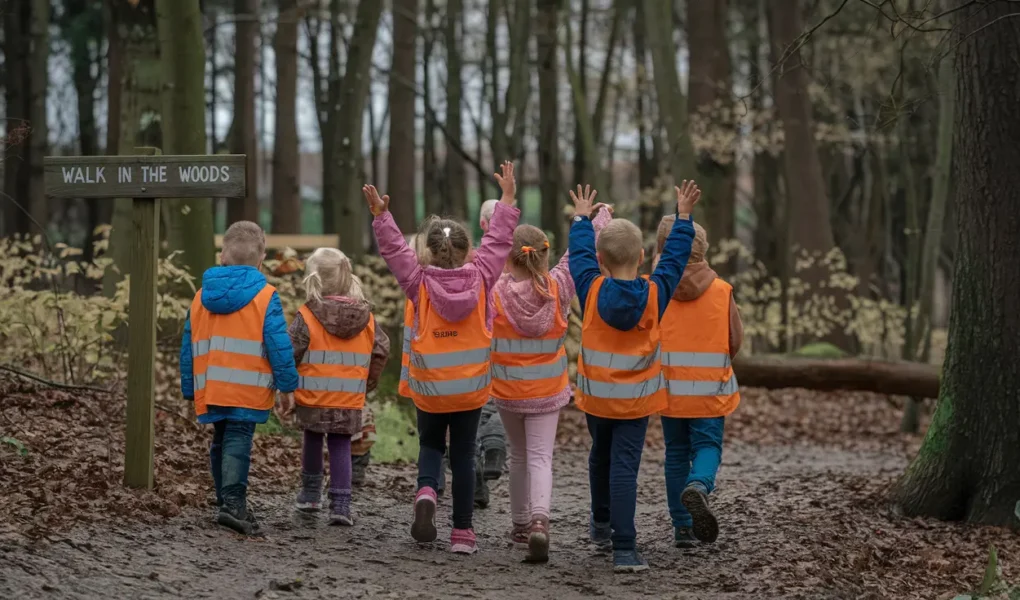Introducing children to nature at a young age is one of the most impactful ways to inspire curiosity and a lifelong appreciation for the environment.
A simple walk in the woods can be a rich educational experience, providing opportunities to learn about ecosystems, wildlife, and the importance of preserving the natural world.
As a parent, your role is crucial in guiding your child through these experiences, fostering a love for nature and the outdoors.
This article serves as a comprehensive parents’ guide for teaching kids about nature during a walk in the woods. It includes practical tips, activity ideas, and strategies to make your outdoor adventures engaging, educational, and fun.
Plan Ahead for Success
Before heading into the woods, take time to prepare. Planning makes the walk enjoyable and stress-free. Choose a safe, family-friendly trail that’s suitable for young children. Look for trails with clear markers and gentle terrain to ensure everyone stays safe. Bring a map of the area and familiarize yourself with the trail route beforehand.
Pack essentials such as water, snacks, sunscreen, bug spray, and comfortable walking shoes. Depending on the season, dress in layers and bring a rain jacket or hat for sun protection. Teaching your child about the importance of being prepared for nature walks is a lesson in itself.
Set Simple Learning Goals
Before starting your walk, think about what you want your child to learn. Kids absorb information quickly when it’s presented in an engaging way. Focus on simple, easy-to-grasp concepts that align with their age and understanding.
For younger children, you might focus on identifying different types of trees, leaves, or animals. Older kids can learn about ecosystems, food chains, and the role of each species in the forest. Setting clear learning goals keeps the walk educational while leaving room for fun.
Encourage Exploration and Curiosity
A walk in the woods is the perfect opportunity to let your child explore at their own pace. Encourage them to observe their surroundings, listen to the sounds of nature, and ask questions. Kids are naturally curious, and a forest walk can stimulate their interest in learning about the environment.
Ask open-ended questions like, “What do you think that animal is doing?” or “Why do you think the leaves change color in fall?” By prompting critical thinking, you help develop their observation and problem-solving skills.
Identify Plants and Trees
Teaching kids to identify plants and trees is a simple way to introduce them to the diversity of the natural world. Bring along a nature guidebook or use an app to help identify different species of plants and trees you encounter on your walk.
Start with basic identification, like spotting oak, maple, or pine trees. Show your child how to look at leaves’ shapes, bark textures, and seeds to identify various plants. As you walk, talk about the role of trees in the ecosystem, from providing oxygen to serving as habitats for animals.
Observe Wildlife
The woods are home to many fascinating animals, from birds and insects to squirrels and deer. Teaching kids to observe wildlife helps them understand the interdependence of living creatures in an ecosystem.
Encourage quiet observation, explaining how animals can be scared by loud noises. Look for animal tracks, nests, and burrows. Bring binoculars for birdwatching, and point out different species of birds based on their colors, songs, or behaviors. Show your child how to respect wildlife by maintaining a safe distance and not disturbing their habitats.
Discuss the Importance of Conservation
A walk in the woods provides the perfect setting to introduce your child to the concept of conservation. Talk about the importance of protecting natural spaces and the animals that live there. Explain how humans can impact the environment, both positively and negatively.
As you walk, discuss the significance of reducing waste, recycling, and keeping natural areas clean. Make it interactive by bringing a small trash bag to pick up any litter you find along the trail. This hands-on activity teaches kids the importance of leaving nature better than they found it.
Engage with the Senses
Nature offers rich sensory experiences, making it an ideal setting for young children to engage with their environment. Encourage your child to use all five senses as they walk through the woods. Ask them to close their eyes and listen to the sounds of the forest—birds chirping, leaves rustling, or water flowing in a stream.
Invite them to feel the texture of tree bark, smell the fresh scent of pine, or touch smooth rocks and pebbles. Engaging their senses will deepen their connection to nature and enhance their learning experience.
Practice Leave No Trace
Introduce your child to the concept of “Leave No Trace” early on. This principle teaches outdoor enthusiasts to respect nature by minimizing their impact. Explain to your child that when walking in the woods, it’s important to leave things as they are so that future visitors and wildlife can enjoy the natural environment.
This includes staying on designated trails, not picking flowers or plants, and taking all trash home with you. Teaching Leave No Trace helps kids develop a sense of responsibility and stewardship for the environment.
Collect Nature Items for Further Learning
While practicing Leave No Trace, you can still collect a few small nature items, like fallen leaves, pine cones, or smooth stones, for further learning at home. Use these items to continue the nature lessons after your walk. Create a nature journal where your child can draw or glue in their collected items, making notes about what they learned during their walk.
Another idea is to start a leaf identification book, where your child can press leaves they’ve found and label the species. These activities help reinforce what they’ve learned and encourage ongoing curiosity about nature.
Make it Fun with Games and Activities
Turn your walk into a fun adventure by incorporating games and activities. A nature scavenger hunt is a great way to engage children during the walk. Make a list of items for them to find, such as a red leaf, an acorn, or a bird’s nest. Give your child clues and let them search for these treasures along the trail.
Other fun activities include bark rubbings (using paper and crayons to capture the texture of tree bark) or “I Spy” games where you describe something in nature and your child has to guess what it is.
Teach Respect for Nature
Respecting nature is a fundamental lesson in outdoor education. Teach your child to appreciate the beauty of the forest without disrupting it. Remind them not to damage plants or disturb wildlife. Explain that the forest is home to many creatures and that we are visitors in their habitat.
Lead by example by being mindful of your actions and showing respect for the environment. This lesson will help instill a deep appreciation for nature in your child.
Introduce Simple Ecology Concepts
Even young children can grasp basic ecology concepts. While walking in the woods, explain how plants and animals depend on each other to survive. For example, discuss how trees provide oxygen, shelter for animals, and food for insects. Explain the role of decomposers like mushrooms and worms in breaking down organic matter and enriching the soil.
Use simple language and visual examples from your surroundings to help your child understand how ecosystems work. These early lessons in ecology can lay the foundation for a deeper understanding of environmental science as they grow.
Encourage Reflection and Observation
After your walk, take some time to reflect on what you’ve seen and learned. Ask your child open-ended questions like, “What was your favorite part of the walk?” or “What animals or plants did you find most interesting?” Reflection helps solidify their learning experience and encourages them to think critically about nature.
Encourage your child to journal about their walk, draw pictures of what they observed, or share their thoughts and feelings about the experience. These reflective activities enhance their learning and foster a deeper connection to nature.
Practice Mindfulness in Nature
A walk in the woods is not only an educational experience but also an opportunity to practice mindfulness. Teach your child to slow down, breathe deeply, and fully immerse themselves in the natural surroundings. Mindfulness in nature helps reduce stress, enhances mental well-being, and cultivates a sense of peace.
During your walk, take moments to pause and appreciate the beauty of the forest. Encourage your child to notice the little details—like the way sunlight filters through the trees or the patterns on a leaf. Mindful walking fosters a deep connection to nature and promotes mental clarity.
Make Nature Walks a Regular Habit
Consistency is key to fostering a lifelong love for nature. FP Moms recommend making nature walks a regular family activity. Whether it’s once a week or once a month, spending time outdoors together builds family bonds and reinforces the lessons you’ve taught.
Explore different trails, forests, and natural environments to keep the experience fresh and exciting. Over time, your child will develop a strong connection to the natural world and an appreciation for outdoor adventures.
Conclusion
A walk in the woods offers endless opportunities for learning and connection. By teaching your child about nature through exploration, observation, and reflection, you can foster a love for the outdoors that will last a lifetime. Encourage curiosity, respect, and mindfulness as you guide your child through the wonders of the natural world. With each walk, you’re not only teaching valuable lessons but also creating lasting memories that strengthen your bond with your child and the environment around you.




